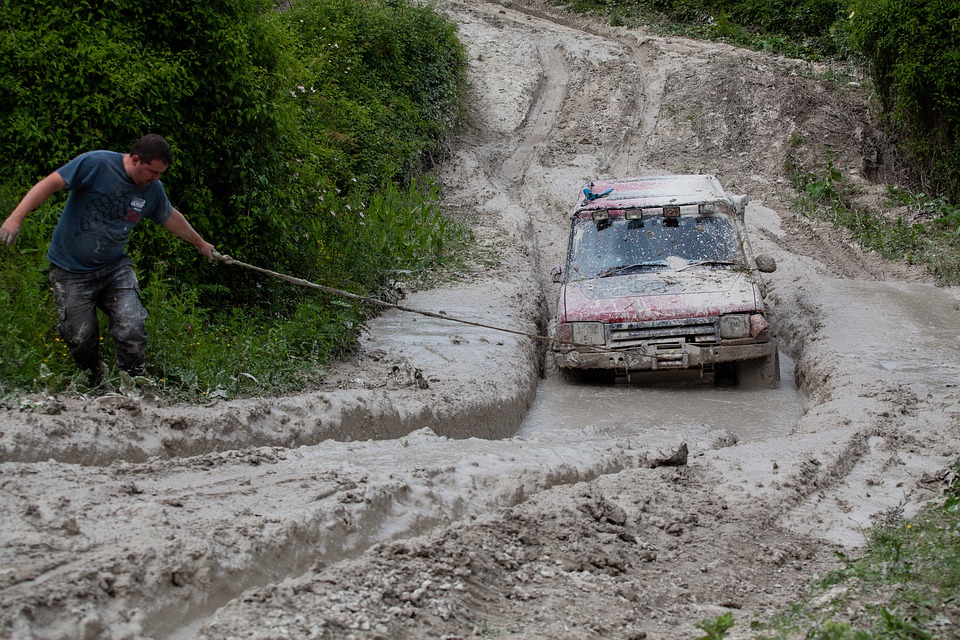Cars that get stuck in mud or sand are frustrating and inconvenient. Fortunately, there are several ways to safely and efficiently unstick your vehicle. If you are alone on the road, the first thing you should do is contact roadside assistance. (Budget Direct Roadside Assistance can only assist you if your car gets stranded on a sealed road that is passable by a standard two-wheel-drive recovery vehicle. However, we won’t abandon you and arrange for a third party to be brought to the scene at your expense).
In essence, you gently accelerate ahead, put your car in reverse and roll backward, switch back to drive, and then slightly accelerate forward again. Use the lowest gear for an automatic transmission and the second or third speed for a manual transmission. Take it gently and build momentum rather than spinning your wheels. You should be able to feel when the car begins to accelerate as the driver. Usually, you can gather enough momentum to push your automobile out of a jam.
If calling for help is impossible or impractical, don’t worry. There are several methods for removing sand or mud from your car.
Vehicle recovery
To prevent making matters worse, you should understand safe vehicle recovery principles before attempting to get your car unstuck. The following are some key points to remember:
- You may be tempted to spin your tires excessively to try and dig your way out of the mud or sand, but this will only dig you deeper. An engine that is continuously revved in a thoroughly stuck car may cause damage to its tires, axles, transmissions, and drivelines and, in most cases, will only worsen the situation.
- You have the best chance of improving traction by increasing the surface area between each drive wheel and the ground if the car is thoroughly stuck. Then, take advantage of the momentum to reach a more solid foundation.
- When you get stuck in sand or mud, momentum is your best friend. Please keep it going once you start moving until you reach more solid ground.
- You should also be in constant communication with other people. It would be best to communicate to them about the driven wheels when you help them out of a bog as a driver.
- There is no foolproof way to recover a vehicle. Based on the type of vehicle and how badly it is stuck, the effectiveness of these methods will vary. Thus, getting your car unstuck may require a lot of trial and error.
Taking stock of the situation
You must understand the severity of the situation if you want to get your vehicle unstuck. If you can safely exit your car, here are a few details that can help you determine what to do next. You will probably have difficulty getting the vehicle unstuck if the wheels are too deep and the axle or chassis are resting on the ground. The car may also be rocking by its frame enough to alter its weight distribution, thereby reducing traction on the drive wheels, or more than one wheel, especially the drive wheels, may be sunken into the slippery-loose material.
How to get the car out of the mud?
As soon as you have assessed the situation, it would help if you started to try to retrieve your vehicle. One method involves snatching two cars. If used correctly, this method can be effective, but you should take a few safety precautions before getting started. The recovery vehicle should be equipped with a 44 traction system and locking differential. Furthermore, it would be best to use only appropriate recovery equipment when attempting this method.
The package includes a 4×4 snatch strap and anchor and recovery points. It would be best not to use the tow ball in your vehicle since it can break and become a projectile. If you use a chain or rope, you may snap them and become a projectile, so never attempt this type of recovery. The strap should be kept well clear of anyone watching the recovery process.
The two-vehicle snatch method involves first attaching the snatch strap to the stuck vehicle’s recovery point. The procedure for attaching the snatch strap varies from vehicle to vehicle; however, most snatch straps will usually come with safety instructions explaining how to connect them, so ensure that this manual is consulted before attaching the waistband. Then, lay the snatch strap on the ground in front of the stuck vehicle and back up the rescue vehicle until barely a couple of meters of slack. Put the strap damper over the middle of the strap and attach it to the rescue vehicle; this will reduce the force of the snatch strap if it breaks.
Read More: A Comprehensive Guide About What Causes Drain Flies?
You should ensure the drivers of both vehicles can communicate clearly before you attempt a rescue. If they can communicate clearly, you should proceed to the return. The car should accelerate smoothly in a straight line on a previously agreed signal, usually a countdown from three, not at full speed. By stretching the snatch strap to its full length and rebounding, you will be able to catapult the stuck vehicle out of the mud or sand. Drivers of stuck vehicles must accelerate when they feel the brake strap pulling their truck forward. They must match the rescue driver’s speed as they accelerate. You may have to repeat the process a few times before gaining sufficient momentum.
Using Rocks
If you cannot move your car using a snatching method, you might be able to use a couple of other ways. One of those methods is rocking. As we have already discussed, the key to getting your car unstuck is momentum. Consequently, rocking the vehicle backward and forwards to gain momentum exactly translates into what it says on the tin: rocking your car back and forth. If your vehicle is completely stuck, this method is unlikely to work since it relies on your vehicle being able to move forward and backward at least slightly.
It essentially involves accelerating slightly forward, then putting your car in reverse and rolling backward, before switching back to drive again and accelerating forward again. For manual transmissions, select the second or third gear. For automatic transmissions, select the lowest gear. Be careful not to spin the wheels in place as you accelerate, aiming to build momentum without stalling. Once the car gains momentum, you will be able to feel it. Often, you will be able to generate enough momentum to get your vehicle unstuck.
The digging technique
The dig approach is simple to understand, yet it may be pretty successful. Take a shovel (preferably, one will be in your emergency kit) and clean as much extra mud/sand from around your tires as possible. If you don’t have a shovel, try scooping with your hands or whatever items you have on hand. This should, in theory, offer you more room to gather momentum and push your way out.
The method for generating random things
Gaining traction is one of the keys to getting your car unstuck. Objects from your car can often be of assistance. Wedging a vehicle mat under your drive wheels, for example, can assist you in generating grip and velocity. Place the carpet beneath the rear passenger side wheel on a rear-wheel-drive car and under the front driver’s side wheel on a front-wheel-drive vehicle. Of course, this is subject to change based on your circumstances. Sticks, leaves, gravel, boulders, and sand are among more materials that might assist you in acquiring traction. Place these things in front of your wheels and accelerate ahead gently. Surprisingly, kitty litter can assist you in gaining traction if you ever need it.
FAQs
- Is it possible to push a car out of the mud?
Here are two options for getting a stuck automobile out of the mud: Increase the traction on the wheels so that the automobile can move out of the earth. Use a winch or another mechanical device to pull the car out of the muck.
- Is traction control beneficial in the mud?
Switching traction control off to allow continued movement in scenarios including sand, mud, or river crossings is a good idea. However, traction control does all the heavy lifting for the vast majority of your off-road driving.









